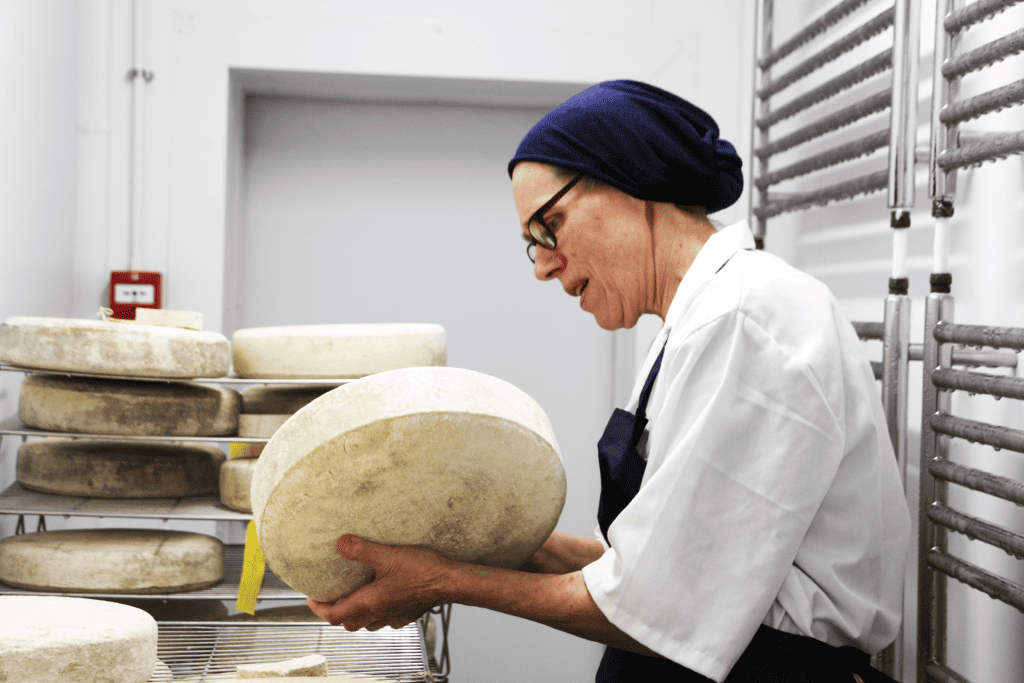Welsh cheesemaker Carrie Rimes of Cosyn Cymruturns “why not?” into “what’s next?”

When driving through the rolling hills of the Northern Welsh countryside, it would be easy to miss Cosyn Cymru, a minuscule dairy headquartered within a former Catholic church that was built following waves of Irish migration in the 1960s. And yet, since early 2023, it’s here that cheesemaker Carrie Rimes has produced Brefu Bach, ironically one of the country’s only sheep’s milk cheeses. “Welsh people really object when people from outside equate Wales with sheep,” says Rimes. “But then I was thinking, well, hang on a minute, why not turn that around and make something of it? Why aren’t we milking sheep here?”
This “why not” mentality has long motivated the warm, effervescent Rimes, punctuating her propensity for thinking aloud. Her speech, even in English, boasts a Celtic musicality. But despite living in Wales for over three decades and raising her son (a traditional Welsh folk musician) here, Rimes is not Welsh, which perhaps motivates her passion for the country and its local terroir. “There’s nothing like the zeal of the converted,” she says.
Rimes grew up on a small family farm in Devon, England. When the pressure of intensification forced her father to sell, her mother arranged to keep a couple of Friesian cows and transformed their rich milk into clotted cream, milk puddings, and soon, cheese. “Looking back on it, they were awful,” Rimeslaughs. Nevertheless, the young Rimes was hooked. “Maybe it was because it wasn’t working, and I had my pride dinged or something. It was like, why?! Why wasn’t it working?
”It would take several decades for Rimes to go looking for an answer.
Finding Fromage in France
First, she devoted herself to environmental science, studying microbial populations in stream water, only to eschew academia in favor of a teacher training course, which brought her to Wales. Soon, she pivoted from education in favor of a job at the Countryside Council for Wales (then the Nature Conservancy Council), focusing on yet another “why not”—one that would reunite her with her earliest passion: “Why on earth,” she says, “weren’t we really celebrating the products that come from the species-rich grassland?”
Consumed by this question, she took early severance from her job to train (again) as a cheesemaker and began looking for the perfect work experience. “I was never going to prove that making cheese from flower-rich pastures was going to be any good unless I had the technique quite right,” she recalls.

With few options in Wales, she hopped the pond to France. Thanks to the World Wide Opportunities on Organic Farms (WWOOF) program, Rimes lived and worked at four different dairies in one summer, from the foothills of the Pyrenees to the peaks of the Montagne Noire. Among them was Raphaël Lefroc’s, whose 18-cow herd grazed on the rich grass of the dormant volcano range of the Auvergne region. At summer’s end, Rimes learned that Lefroc was “desperately short of help,” and though she was still green, she found herself in charge of the dairy, specifically producing his little lactic P’tits Bibis, which Lefroc himself continually threatened to abandon.
“‘They take a lot of time; they never seem to work for me. Ugh, I’m gonna give them up,’” she recalls him lamenting. But Rimes wasn’t deterred. Motivated by the question that nagged her constantly, she asked permission to take a stab at mastering them.
“He sort of grudgingly agreed, and over time, we experimented, and I think they perhaps got a little bit more consistent? I don’t know.” Rimes remained in the Auvergne for nearly three years.
Resurfacing Welsh Terroir
Upon her return to Wales in 2014, Rimes had a new passion project: making her own sheep’s milk cheese in the Welsh countryside.
Of the three types of milk Rimes worked with in France, she found sheep’s milk to be the most satisfying.“ It just asks to be made into cheese, really,” she says, because it has higher fat content than cow, goat, and even buffalo. Because Wales is home to around 10 million sheep, it seemed like the perfect place for her project—provided she could find a dairy. Because the “vast majority” of sheep in Wales are bred for meat and would yield little milk, she explains, it took sometime before she stumbled upon Sheep Milk Company, a Lancashire dairy co-founded by Simon Stott, Farmers Weekly’s 2011 Sheep Farmer of the Year.
At first, she started with a few 20-liter (5 gallon) buckets of milk, making cheese at the local food technology center. Soon after, she moved to Caws Rhyd Y Delyn dairy on the isle of Anglesey, which was shared with Menai Wyn Jones, the producer of Môn Las blue cheese. But it wasn’t long before she purchased the church building in 2018. After several years of renovations, which were further delayed by the pandemic, she finally moved into the space in March 2023.
Today, Rimes sources her milk locally from two farmers who graze their Lleyn sheep on the grassy Llŷn, a large peninsula that extends into the Irish Sea. Her lactic Brefu Bach, inspired in part by the P’tits Bibis she learned to make alongside Lefroc, is the star of her offerings, beloved across Wales and the UK thanks in large part to a collaboration with Neal’s Yard Dairy born from a “cheeky” impromptu visit to their Covent Garden branch years ago.“
I sort of just turned up on spec at Neal’s Yard, dug into my rucksack, pulled out a bit of the sort of Welsh cheese I’d been making over there in France,” she recalls. “I plonked it on the counter, and said, ‘What do you think of that, then?’
“They found her efforts at the time a bit “farm-yardy,” she recalls, but once she’d perfected the little lactic cheese’s recipe, they began selling it to Londoners for £11.25 (about $12.15) a pop.
Brefu Bach has broad appeal, not only because of its light, fluffy texture and fresh, creamy flavor, but also because it’s vegetarian. It requires just a touch of thistle rennet to achieve a lovely, soft curd. But the rennet, which Rimes sources from French company Coquard, has become far more difficult to acquire since Brexit—a change that has motivated her to plant a patch of cardoon thistles behind the church in hopes to produce her own. And this isn’t her only plan for the future.
The Final Frontier
For some time, Rimes has had her heart set on perfecting the sort of cheese she imagines would have traditionally been made in Northern Wales: a long-aged hard cheese like Caerphilly. But despite years of trying, it’s proven difficult to master.
“I’ve come to the conclusion that with just straight sheep’s milk, it’s a right faff,” she says. And given the history of the region it makes sense. With the nineteenth century advent of railways, she explains, “it looks as if people went over entirely to milking cows, because you could get your milk down to London, and you could make butter.” She posits that people would have continued milking sheep small-scale, “bulking out” the skim milk with sheep’s milk to make what she imagines would have been “a decent cheese.” And she’s eager to make it herself—if she can source the milk.

Welsh Black cattle are some of the oldest in Britain, descended from pre-Roman breeds and known for their sturdiness, perfect for the rough mountain and hilly terrain. But these days, Rimes is faced with a similar quandary to the one she encountered with her Brefu Bach. Most Welsh Blacks are bred for meat; however, Rimes has her sights set on persuading someone to milk them. “It may not work, of course! It maybe an absolute total disaster,” she says merrily. If it is, there’s no doubt she’ll “why not” her way into a solution.
Welsh Cheeses You Should Know
If the only Welsh cheese you’ve heard of is Caerphilly, you’re missing out. Here are just a handful of the phenomenal cheeses Wales is known for:
Black Sheep
Black Sheep may look like many of Caws Cenarth’s wax-coated truckles, but this one stands out in more ways than one. Made with sheep’s milk, it boasts a rich, creamy texture and subtly nutty character with slight lanolin funk. It’s no surprise that, despite being a relative newcomer to the cheese-scape, it’s already earned accolades, including a Gold at the 2019 Royal Welsh Show.
Perl Las
Perl Las means “blue pearl” in Welsh, and it’s the perfect moniker for this bloomy-rind blue made by Caws Cenarth on the island of Anglesey. Smooth and mild with delicate, yet lingering, bitter blue character, it’s available in multiple sizes and shapes, including 200g (7-ounce) mini truckles that make a perfect cheese board centerpiece.
Saval
John Savage-Onstwedder is a household name among Welsh turophiles. The country’s longest-established artisan cheesemaker, Savage-Onstwedder is also Britain’s most highly awarded. While his Caws Teifi is perhaps best-known for its organic gouda-style cheeses, don’t sleep on Saval, a Caerphilly-based washed-rind cheese with a soft, buttery center and a rich, brothy funk
Hafod
You’d be forgiven for thinking Hafod is a cheddar, but despite its similarities, it’s a traditional Welsh hard cheese made on Bwlchwemen Fawr, the country’s longest certified-organic dairy farm. It’s delightfully intense with sweet, buttery, nutty notes, traits indicative of the Swiss training of the late Dougal Campbell, the recipe’s inventor.
Abaty Brie
Abaty Brie is an organic Brie-style cheese from Aberystwyth in West Wales and one of the only raw-milk Bries made in the UK. A relative newcomer, the cheese is rich and velvety with a slight citrus flair. It’s sure to please any fans of French Brie de Meaux.
Related:
- One Cheesemaker’s Horseback Journey Through Mongolia
- The Divergent Paths of Three Cheesemakers
- One Cheesemonger’s Journey Beyond the Counter and Into the Field




